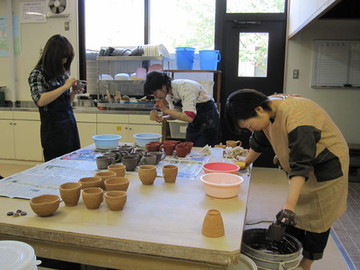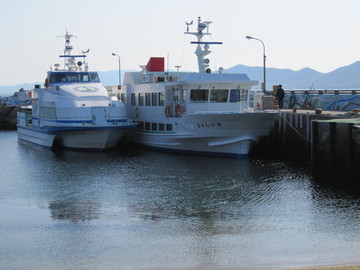2010年06月29日
Glimpses of Ogijima
Setouchi International Art Festival – Prelude 5
Glimpses of Ogijima
Glimpses of Ogijima
I recently visited Megijima and Ogijima islands to write a special feature on the festival for the Takamatsu International Association’s English newsletter*. These two islands are just 20 minutes and 40 minutes, respectively, from Takamatsu on the same ferry. With the ferry rates being reduced drastically and the number of crossings increased during the festival, they’ll be very accessible. Below I’ve included a few glimpses of Ogijima that would not fit into the newsletter.
* See http://ww2.enjoy.ne.jp/~tia . The newsletter will be online from July with details about the art sites, access, etc.
Wall Paintings by Rikuji Makabe
Rikuji Makabe uses a variety of materials as his canvas. On Ogijima, he painted designs on boards, which he then fixed to the walls of local buildings, adding creative accents to the village streets. It was great fun walking down the narrow lanes and stumbling upon his works. He has picked great spots for drawing the visitor’s attention to the island’s spectacular views. During the creative process, he lived on the island, receiving inspiration and choosing the sites and it shows in the designs and locations.


Telephone by Tomoko Taniguchi
While wandering the streets of Ogijima, I came across artist Tomoko Taniguchi who was straddling a steep creek with a string in her hand. She was in the process of laying out a pipe telephone network. These phones will operate on the same principle as two paper cups joined by a string. I was only able to get a photo of a photo but it looks like fun! Watch out for the phones when you’re there and try talking down them.

Local “Fast Food”
There is a tiny local “fast food” joint across from the port with a very limited menu. Located to the right of the stone torii (shrine gate), it’s open from noon until about 5 PM. It was a hot day so I tried the tokoroten, a kind of noodle-shaped seaweed jelly eaten with soy sauce and mustard or vinegar. Very refreshing. The woman who runs the shop harvests and processes the seaweed herself.
Main Attraction
I asked Yoshifumi Oshima of the Onba Factory project team what was the main attraction of this festival. In his words: “In contrast to such artificial playgrounds as Disneyland, the Seto Inland Sea is nature’s real wonderland. The lifestyle of the islanders has remained virtually the same for decades, yet for us, their ordinary lives are extraordinary. When you step onto a ferry and head out to the islands, you slip through time into a different world – beautiful just the way it is… We hope to present these islands in ways that will contribute to creating a viable livelihood for the islanders and attract others who appreciate their beauty.”
Ogijima – a wonderland with wonderful people, like the man who stopped his truck just to give this middle-aged lady a flower!

photo:ogijima
2010年06月16日
The Gentle Art Project*
Setouchi International Art Festival – Prelude 4
The Gentle Art Project*
Oshima is a small, scenic island with a population of about 100 people. Located 25 minutes by boat from Takamatsu along the northeast shore, it is still within the city limits. It is also one of the seven islands included in the Setouchi International Art Festival (July 19 – October 31). The art project in process is tailored to the island’s unique history.
In 1909, Oshima became a sanatorium for people suffering from Hansen’s disease (leprosy). Leprosy prevention laws in Japan from 1907 onwards required that people with Hansen’s disease be completely segregated from society. Due to social stigma and discrimination, patients remained incarcerated for life in isolated colonies such as the one on Oshima. Although advances in medicine made it possible to eliminate the disease by the mid-1980s, the law in Japan on forced quarantine was only repealed in 1996. Oshima’s facilities now provide treatment as well as educational activities to increase public awareness of the disease. Island residents are all former patients who have been cured but who need care due to advanced age and the residual effects of the disease.

The Oshima Gentle Art Project* is a collaborative effort between artists and residents and it is being implemented by graduates of Nagoya Zokei University of Art and Design under the direction of artist Nobuyuki Takahashi. Core team members have been visiting Oshima for the last two and a half years, getting to know the islanders and working with them to prepare for the festival. An old dormitory has been transformed into an art gallery to display photography, paintings, bonsai and other art forms on the theme “Pine”. In addition to artwork, residents have also contributed objects representing their daily life in the sanatorium, for example, rice ration tins and artificial limbs, and these are being incorporated into an innovative display.



The project includes a café that will serve sweets and drinks made with vegetables, fruits and flowers grown on the island. Even the dishes are artworks, made of island clay by volunteers under the direction of an island potter. Teams of volunteers have been commuting regularly to clean and decorate the café and to harvest, boil and freeze quantities of fresh mugwort. The latter will be used to make an old Oshima specialty – mugwort pound cake. The café will be open throughout the festival.
One of the Art Festival’s aims is to bring new life into the islands and the following comments from the islanders suggest that this project is succeeding:
“It makes me so happy to hear cheerful young voices on the island.”
“This is the first time anything like this has happened here. I’m so excited!”
Access:
By boat 3 times a day leaving from Dai-ni Ukisanbashi (2nd floating pier) at Takamatsu Port. Departure times are 9:10, 11:00 and 13:55. Return times are 10:30, 13:25 and 16:15. No fare is charged but you do need to get a ticket. Tickets are available at the International Art Festival Office located on the first floor of the Takamatsu Port Terminal Building (across the street from the ANA Clement Hotel on the west side). Please check the festival site as well for any further updates on this information during the festival. http://setouchi-artfest.jp/en/about/

* Gentle Art Project (Yasashii Bijutsu Project):
This term was coined by Nagoya Zokei University and is not limited to the project in Oshima. It refers to art projects in which the hospital, artists and designers collaborate to create a medical environment that promotes peace of mind and a medical facility that is open to the community. The university’s students and graduates are implementing such projects in other locations as well. See: http://setouchi-artfest.jp/en/artist/yasashii_bijutsu_project/
Credits:
Many thanks to the Koebitai volunteer corps for providing detailed information via their newsletter and blog. (For those of you who read Japanese, refer to Koebitai blog http://www.koebi.jp/blog/index.html )
2010年06月03日
Takamatsu Sea Lights
Setouchi International Art Festival – Prelude 3
Takamatsu Sea Lights
Takamatsu Sea Lights
Preparations for the Setouchi International Art Festival (July 19–October 31) are booming right along. Artists and corps of volunteers are currently hard at work creating art installations with the support of local citizens. Takamatsu is one of the 8 sites that will be featured and there are some exciting projects already underway right here.
One of these is "Takamatsu Sea Lights" under the direction of Noboru Tsubaki, head of the Space Design Section at Kyoto University of Art and Design. Tsubaki is a versatile media artist and a creator of large outdoor installations addressing social and political issues. He began making large-scale illuminated sculptures several years ago as a teaching tool when he discovered that an increasing number of students entering fine arts universities couldn’t hammer a nail, frequently cut themselves when they tried to use a box cutter and didn’t even know the most rudimentary elements of history or philosophy. To overcome this handicap, he decided to design workshops that started from “scratch”, providing basic education that would help students develop mind-hand coordination. He particularly needed a workshop that would engage students in a cooperative team effort. The huge illuminated floats called Nebuta displayed in the Aomori Nebuta Festival caught his attention and he went all the way to Aomori to learn how to make them. (See: http://en.wikipedia.org/wiki/Aomori_Nebuta_Matsuri )
For the "Takamatsu Sea Lights Project," fifteen teams of volunteers have been creating illuminated sculptures 2 to 3.5 meters in height. According to Tsubaki, the simple structures of wire, wood and paper are surprisingly easy to build. The sculptures will be unveiled in the large open plaza behind Sunport on the evening of July 18 in a special illumination ceremony. The ceremony will also include a procession of handheld lanterns made by local citizens. The theme is “Sea Creatures,” so expect to enjoy a glow-in-the-dark underwater fantasy. To get an idea of the scale and creativity involved, check out Yonden Plaza in Sunport across from Takamatsu JR station. An illuminated sculpture called Ice Age is currently on display as well as an illuminated panel of mythical creatures.
The project team is calling for volunteers. If you read this information in June or early July and are interested in participating, please contact 087-813-1001. The organizers only speak Japanese, so get a friend to help you if you can’t speak it. Volunteers will be assigned to one of the sculptures currently under construction. In addition, workshops will be held from mid-June to early July in the Takamatsu shopping arcade at which participants will make their own personal lanterns to use in the procession on July 18. Again, please call the above number for details on place, time, etc.
For more information about Noboru Tsubaki, check out these sites:
http://web.mit.edu/arts/announcements/prs/2006/1010_tsubaki_rubin.html
http://www.momak.go.jp/English/exhibitionArchive/2008/371.html
Credits:
Many thanks to the Koebitai volunteer corps for providing detailed information via their newsletter and blog.
(Koebitai blog http://www.koebi.jp/blog/index.html )



